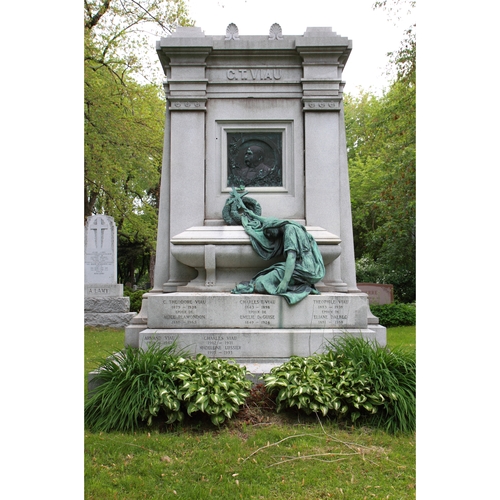
Source: Link
VIAU, CHARLES-THÉODORE, businessman; b. 17 March 1843 in Longueuil, Lower Canada, son of Marc Viau, dit Cinq-Mars, a carter, and Florence Deniger; m. 18 May 1868 Marie-Émilie Deguise in Montreal, and they had numerous children, some of whom died at an early age; three sons and four daughters survived him; d. 10 Dec. 1898 in Longue-Pointe (Montreal).
Having come to Montreal at the age of 15, Charles-Théodore Viau was hired as a clerk in a grocery store, where he learned the tricks of the trade. He is thought to have become proprietor in 1866. It is known that from 1866 he and a partner ran a wholesale grocery establishment, Dufresne et Viau, on Rue des Commissaires in the business district. He soon decided to specialize in the flour trade. In 1867 he extended his interests to include bread and shortly thereafter he began to manufacture biscuits, which were to become his main product. Viau changed his partner in 1870 and the firm took the name of Viau et Viger; three years later he became its sole owner and carried on business as Viau et Frère. At the same time he abandoned his store on Rue des Commissaires. The Viau factory was installed in premises on Rue Sainte-Marie (Rue Notre-Dame) in the city’s east end and was enlarged several times, with more substantial renovations being made after it burned down in 1875.
Viau was first and foremost a manufacturer and he spent his adult life building up and developing his business. Over the years he expanded and diversified his products. Although he stopped making bread in 1890, he continued to deal in flour and produced a wide variety of biscuits as well as candies and chocolates. Always on the look-out for technological innovations, he sought to put modern machinery into his factory. In 1894 the firm had 125 employees and $300,000 in sales. It was considered one of the most important biscuit companies in Canada, with a market covering primarily Quebec and part of Ontario.
Like many businessmen of his day, Viau invested in real estate. He owned property in the east end of Montreal, but his most important acquisitions were the vast tracts of farmland he bought between 1884 and 1886 in Maisonneuve and at Longue-Pointe, on the outskirts of Montreal. There he kept a herd of cows to provide milk for the biscuit factory. At a time when it was difficult to obtain good-quality milk, he thus had an assured supply that he could control; the arrangement furnished an interesting example of vertical integration. He established his family residence on the banks of the river at Longue-Pointe. In the course of the 1890s he decided to use his property for urban development and made an agreement with the municipal council of Maisonneuve to put in roads.
However, Viau had more in mind than an ordinary subdivision, and he worked out a plan for a model town, which he called Viauville. Displaying urban concerns then rare among francophone land developers, he required the purchasers of lots to put up stone-façaded houses of no more than two storeys, set back from the sidewalk. The lots along the riverfront he put aside for parkland. He got the archdiocese to create the parish of Saint-Clément in 1898, its boundaries corresponding to those of his estate. Since the population was still quite small he undertook to provide for the lodgings and keep of a curé, and he contributed heavily to the financing for the building of the church. At the time of his death he also cherished the idea of having this enclave incorporated as a separate municipality. In the end Viauville remained an integral part of Maisonneuve, but the plans for development he had conceived were carried out by those administering his estate after 1898. The grey stone façades of Viauville still testify to his originality.
Having become a respected businessman, Charles-Théodore Viau was a member of the Montreal Board of Trade and, from 1895, of the Chamber of Commerce for the district of Montreal. He was a well-known Conservative, but does not seem to have been very active in politics. At his death he left the sizeable enterprise with which the Viaus were to be associated for nearly a century, and a name virtually synonymous with biscuits in Canada.
AC, Montréal, Minutiers, M.-G. Ecrement, nos.222, 252, 523. ANQ-M, CE1-12, 19 mars 1843; CE1-51, 18 mai 1848, 14 déc. 1898. Arch. de la ville de Montréal, Fonds de la ville de Maisonneuve, dossier 1-1. BE, Hochelaga, reg., A5: 27; D10: 715. La Patrie, 12, 14 déc. 1898. La Presse, 12, 14 déc. 1898; 6 mai 1899. Montreal directory, 1865–98. Montreal illustrated, 1894 . . . (Montreal, [1894]). P.-A. Linteau, Maisonneuve ou comment des promoteurs fabriquent une ville, 1883–1918 (Montréal, 1981). [Roger Viau], Un siècle de progrès; historique de Viau Ltée (Montréal, 1967).
Cite This Article
Paul-André Linteau, “VIAU, CHARLES-THÉODORE,” in Dictionary of Canadian Biography, vol. 12, University of Toronto/Université Laval, 2003–, accessed December 29, 2025, https://www.biographi.ca/en/bio/viau_charles_theodore_12E.html.
The citation above shows the format for footnotes and endnotes according to the Chicago manual of style (16th edition). Information to be used in other citation formats:
| Permalink: | https://www.biographi.ca/en/bio/viau_charles_theodore_12E.html |
| Author of Article: | Paul-André Linteau |
| Title of Article: | VIAU, CHARLES-THÉODORE |
| Publication Name: | Dictionary of Canadian Biography, vol. 12 |
| Publisher: | University of Toronto/Université Laval |
| Year of publication: | 1990 |
| Year of revision: | 1990 |
| Access Date: | December 29, 2025 |




